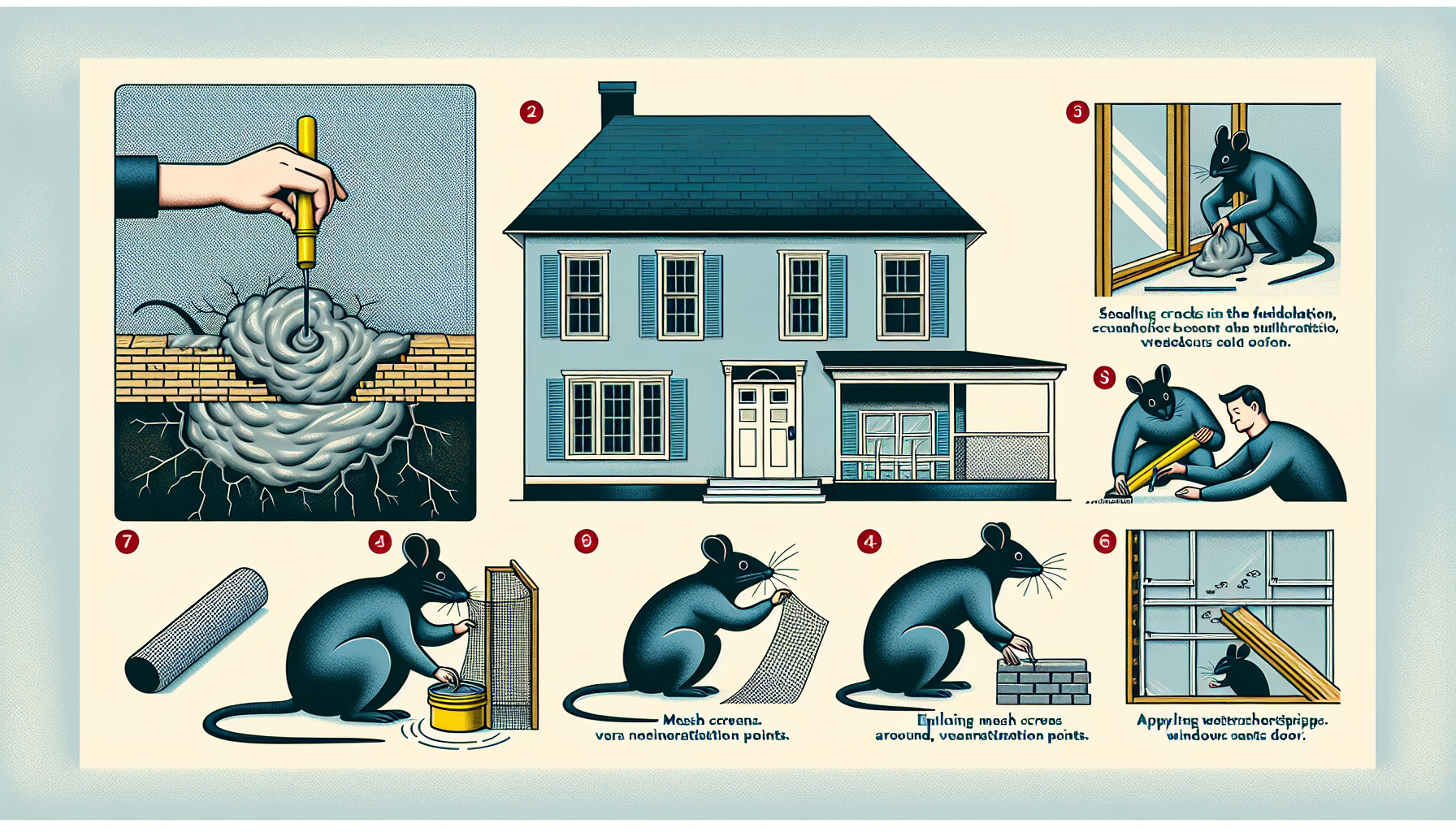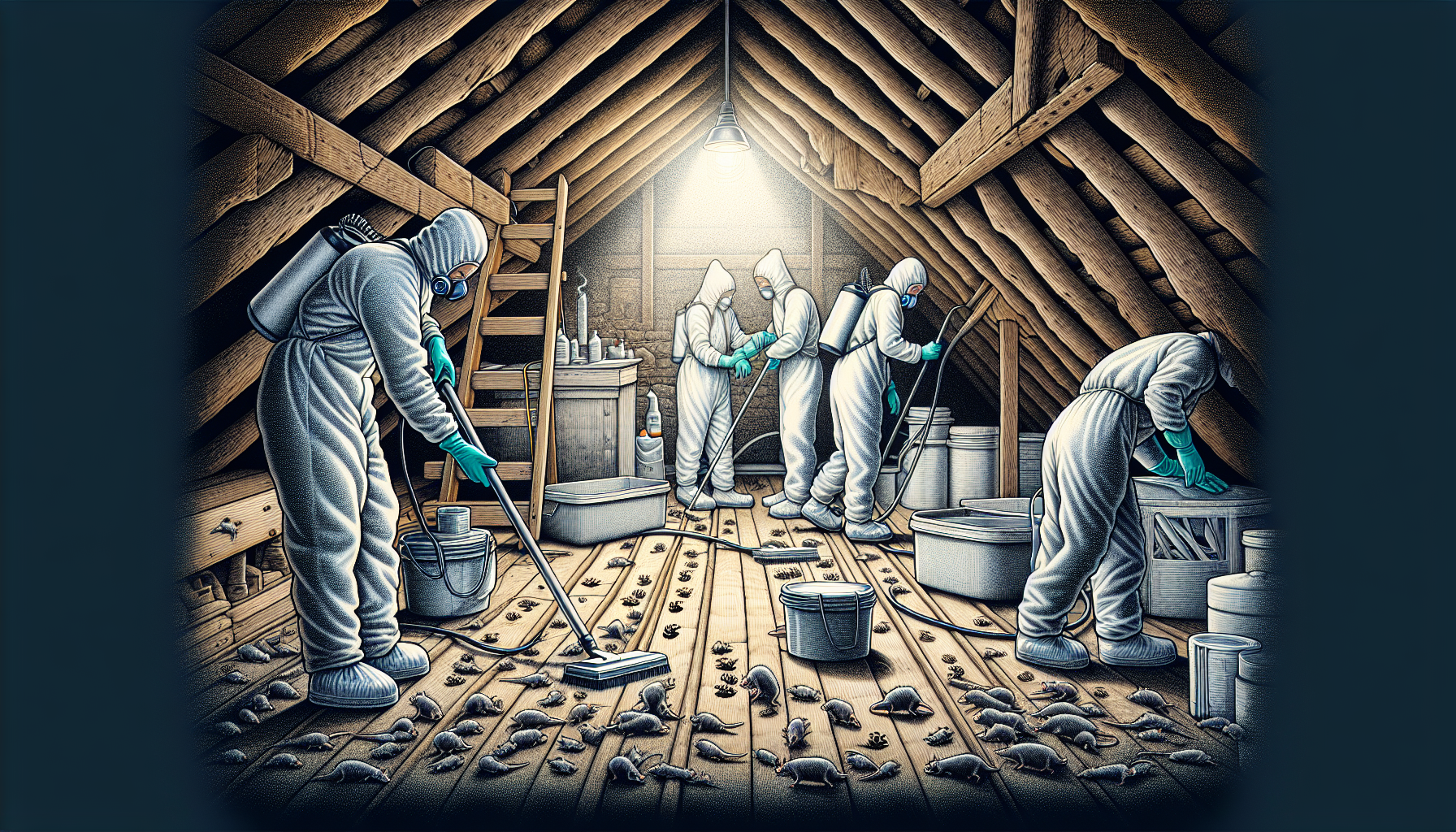How Can We Get Rid of Rats for Good?
Got rats? Discover how we can get rid of rats efficiently. Our guide provides steps to identify infestations, seal entry points, and use traps for a rat-free home.
Rats
- Preventing rats from entering homes involves sealing all entry points, proper food storage, and eliminating water sources.
- Effective outdoor rat control includes maintaining a clean yard, removing clutter and food attractants, and setting traps strategically.
- Professional help should be sought for large or persistent infestations, as DIY methods may not be sufficient to completely eradicate rat problems.
Identifying Rat Infestations

Identifying a rat infestation is critical as the first measure in managing this problem. Rats are adept at keeping hidden, and their existence might not be detected until there’s a significant issue. To ascertain if you have rats, search for definitive evidence including:
- feces
- bite marks
- footprints
- burrows
Along with these indicators, noises such as scampering and scratching within wall cavities during nighttime can suggest the presence of rats.
A thorough examination is imperative to find where they dwell, move about, and eat.
Common Signs of Rat Activity
Recognizing the presence of rats is crucial for timely and successful rat management. One of the most notable indicators of rat activity is their droppings, which are typically small, dark, and resemble pellets. Additional evidence includes bite marks on items like furniture, electrical wiring, and food containers.
Evidence such as tracks in dusty areas or nests constructed from torn paper, fabric pieces or plant matter should also be noted. Sighting dead rats serves as another confirmation that an area may be infested with these rodents.
Types of Rats
Before initiating a rodent control program, it’s crucial to determine which of the two main rat species has invaded your home: Norway rats or roof rats. The larger Norway rats have an affinity for moist environments such as basements, whereas the smaller roof rats are known to occupy elevated areas like attics and roofs. Recognizing these distinctions is key to effectively addressing the infestation.
Preventing Rats from Entering Your Home

To avert rats from invading your space, the initial step is to block their access to your dwelling. Scrutinize meticulously and plug any potential ingress routes. Remember that openings as tiny as 1.25 cm (1/2 inch) must be sealed since they can easily wriggle through them. Hence, it’s critical to ensure that all gaps larger than 14 inch are secured.
Discouraging rats entails correctly storing food and removing water sources, two key attractions for these pests.

Squirrel Control Services
- Humane Removal Services
- Squirrel Control Services
- Red Squirrel Proofing Services
- Nest Extraction Services
- Vent Replacement Services
Seal Entry Points
Rats possess the ability to compress their bodies and fit through gaps as tiny as a dime. To block these exterior access points, employ methods such as caulking, spray foam, or stuffing them with steel wool. Apply caulk around the steel wool to secure it.
For rectifying bigger openings, utilize robust materials like lath screen, metal sheeting or cement. Ensure that sizable apertures in external buildings are covered using weather-resistant and rat-proof substances such as cement or metal sheets.
Proper Food Storage
To deter rats, store food in rodent-proof containers made of materials like plastic, metal or glass that have secure lids. Ensure that pet and bird feed is stored in airtight containers resistant to gnawing to eliminate potential food sources for the pests. Employing bird feeders can assist in keeping feed off the ground and contained.
Eliminate Water Sources
Leaky faucets, faulty irrigation lines, swimming pools that are not well-maintained, and pet water bowls are all common attractants for rats as they provide a source of water. To prevent these rodents from being attracted to your space, make sure to repair any leaking taps or pipes promptly, manage pool maintenance diligently, and regularly clean and dry out the containers used for feeding pets.
Eliminating sources of standing water is vital in order to deter rats and effectively get rid of rat infestations. By removing such attractions, you can help keep your area free from rats.
Outdoor Rat Control Techniques
Maintaining a neat yard by keeping it well-trimmed is crucial for outdoor rat control, as this can deter rats from entering your home. It’s important to eliminate accumulations of wood, brush, debris, compost, as well as dense shrubbery and ivy, which may provide shelter for rats.
Eliminating possible sources of sustenance for these rodents will aid in their prevention. Ensure that any pet food that has been left outside is removed along with fallen fruit or seeds that have spilled. Such measures are key in mitigating the presence of rats.
Yard Maintenance
Rats are attracted to cluttered areas because they offer ideal conditions for:
- Concealment
- Rest
- Building nests
- Multiplication
By maintaining a space that is devoid of clutter, you can diminish the chances for rats to carry out these activities. Ensuring your environment is tidy and uncluttered serves as a simple yet efficient strategy in deterring rat infestations. Consistent cleaning efforts will aid in eliminating potential refuges and sources of sustenance for these vermin.
To deter rats from reaching your roof, prune tree branches so they stand at least four feet away from both the roof and walls of your house. It’s also advisable to position any compost bins securely at a distance no less than 100 feet from your dwelling. Promptly harvest vegetables or fruits from gardens or orchards when ripe to reduce enticements for rats.
Removing Attractants
Recognizing the elements that draw rats to your outdoor spaces is crucial for warding off invasions. Common lures consist of:
- Waste from pets
- Food designated for pets
- Accumulations of trash
- Residues on barbecue grills
- Feeders intended for birds
- Fruit and nuts left unpicked
To keep rats at bay, it’s advised to compost using a fully sealed tumbling bin situated no less than 100 feet away from your dwelling.
Maintaining cleanliness in places where rodents have frequented is essential to prevent new infestations of rodents and to minimize the spread of diseases they may carry.
Squirrel Removal Cost
- Removal: One-Way Door, Trapping
- Repair: Shingles, Vents, Soffit
- Prevention: Reinforce Vulnerable Areas
Setting Traps to Catch Rats
Trapping rats is an established strategy for capturing these pests. There are different kinds of traps such as snap traps, electronic traps, and live cages designed specifically for this purpose. The most effective means to eliminate rats are considered to be both the snap trap and the electronic variety.
Effective rodent management requires a thorough grasp of rat habits, tactical positioning of your chosen devices, and making adjustments to your trapping tactics should the rodents manage to escape capture.
Snap Traps
Snap traps are a traditional and efficient means to catch rats, renowned for their simplicity and effectiveness when used with properly selected bait and strategically placed. Employ strong-smelling foods like nuts or moldy cheese as bait, ensuring the portions are minimal and well-placed in the center to stop rats from stealing it without being trapped.
Electronic Traps
Electronic rat traps are equipped with these characteristics:
- Instant extermination of rats is achieved through a high-voltage shock.
- There is No need for food bait to attract rats.
- A single set of batteries has the capacity to eliminate as many as 50 rats.
- These devices usually feature alert systems that signal when a trap has secured a rat.
Certain models of electronic traps come with Wi-Fi connectivity, enabling them to transmit alerts directly to your smartphone upon capturing a rat.
Live Traps
Rat traps that catch and hold the rodents live permit their removal from premises without resorting to lethal means. This method is particularly appropriate for settings with children or pets, as it avoids killing the rats.
To manage rat populations humanely, it’s vital to regularly monitor live traps. Consistent checking ensures that any trapped rats endure minimal distress during capture.
Using Baits and Poison

Bait stations can serve as a potent method to manage rat populations by taking advantage of their foraging behavior. They also pose certain hazards. The bait boxes must be strategically positioned to maximize both efficiency and security.
Although rodenticides can exterminate rats, they present substantial dangers not only to humans but also to pets and other wildlife species. Consequently, these substances ought to be employed only when no other options remain.
Bait Stations
To ensure they are tamper-resistant, bait stations ought to be equipped with locks or hidden latches. This practice in rodent control allows for the safe administration of poison specifically to rats, thereby reducing danger to humans and animals that are not intended targets.
The strategic positioning of these bait stations is vital. They need to be situated along the path connecting the rodents’ nesting areas and their food sources.
Poison Baits
Rodenticides that need to be ingested multiple times by rodents over several days can successfully eliminate them. There is a chance that these pests may expire in hard-to-reach areas, resulting in unpleasant odors and potential insect problems.
It’s recommended to continuously provide new bait for a minimum period of 10 days or until there are no longer any indications of rat activity present.
Natural Rat Repellents
Eco-friendly alternatives to chemical solutions for pest control include natural rat deterrents. By integrating certain plants into one’s garden, homeowners can create a barrier that deters rats from invading their living spaces. The use of essential oils such as peppermint and eucalyptus serves as an organic repellent.
Although these approaches may lack the rapid efficacy of glue traps or toxic substances, they provide a more sustainable and less hazardous strategy for managing pests like rats.
Plant-Based Solutions
Incorporating certain plants offers a non-toxic, environmentally friendly approach to keep rats away from homes and gardens. Mint has proven highly effective for repelling rats. Alternatively, using balsam fir oil or scattering small branches can naturally deter rats in problematic areas.
Essential Oils
Natural repellents such as peppermint and eucalyptus essential oils have proven effective in keeping rats at bay from both your home and garden. The potent aroma of peppermint oil is particularly known to deter rats.
Diluting peppermint away in water creating a spray solution for application on garden vegetation can act as a deterrent against rat intrusions.
Cleaning Up After Rats

To mitigate health hazards, cleaning up meticulously following a rat infestation is crucial. It’s advisable to wear rubber or plastic gloves and possibly wear a dust mask to prevent breathing in particulate matter while dealing with rat urine and feces.
Before initiating the cleanup process, ensure that you have aired out the space by opening every door and window for no less than 30 minutes, enhancing air flow and diluting residual smells. Spray either a bleach mixture or an everyday disinfectant on the affected surfaces and allow it to stand for 5 minutes before scrubbing away.
Protective Gear
To diminish the chances of acquiring illnesses such as Hantavirus, Leptospirosis, and Salmonella when faced with rat infestations, it is crucial to wear protective attire. Consider following these guidelines for proper use.
- Gloves should be worn to shield your hands from making direct touch with surfaces that have been tainted.
- Employing a mask is advised so as not to breathe in dust potentially laden with dangerous bacteria or viruses.
- It’s imperative that every piece of protective clothing fits well and remains on throughout any encounter with areas affected by rats.
Disinfecting Contaminated Areas
Liberally apply a household disinfectant or bleach solution to the contaminated space, ensuring it is thoroughly saturated, and allow this to penetrate for 5 minutes to sterilize the area. Following the initial cleaning of any contamination, go over the surface once again with a mop or sponge using your chosen cleaning agent.
You must avoid sweeping or vacuuming up rat droppings, urine, or nesting materials. These actions can propel particles into the air leading to possible inhalation and enhancing chances for spreading contaminants through airborne transmission.
When to Call a Professional
If your do-it-yourself methods fall short in curtailing rat activity, it is advisable to turn to skilled professionals. The recurrence of pest infestations, even after considerable personal attempts at eradication, indicates that the expertise and skills of pest control specialists are necessary. These experts can impart valuable knowledge, implement effective traps and baits, and apply their proficiency to ensure that the issue is thoroughly addressed.
Numerous pest control firms provide a complimentary needs analysis to recognize the specific type of pest involved and formulate an appropriate plan for treatment.
Large Infestations
Professional pest control is typically necessary to effectively handle significant infestations, as do-it-yourself approaches may not be sufficient. When DIY treatments fail to eliminate a pest issue after multiple attempts, it suggests the severity of the problem requires expert intervention.
The assurance that comes with professional pest management can relieve concerns about persistent pests. It guarantees that once addressed, the pest issue will not resurface in just a matter of weeks.
Pest Control Services
Leading pest control firms, such as Terminix and Orkin, provide tailored treatment strategies for a variety of pest infestations. Ehrlich presents its PestFree365 program, which delivers continuous defense against more than 30 varieties of pests throughout the year.
These companies not only rid your residence of rodents, but also offer sustained safeguards to deter subsequent invasions.
Summary
Ridding your home of rats requires a multi-faceted approach. From identifying infestations and sealing entry points to setting traps and using natural repellents, each step is crucial in controlling rat populations. Remember, cleanliness and proactive measures are your best defenses against these pests. If the problem persists, don’t hesitate to call in the professionals. With determination and the right strategies, you can reclaim your home and ensure it remains rat-free. Take action today and safeguard your home for the future.
Frequently Asked Questions
What are the most common signs of a rat infestation?
Indicators of a rat infestation typically encompass the presence of droppings, evidence of gnawing, visible tracks, nest sightings, and nocturnal noises such as scampering or scratching emanating from within walls.
It’s critical to respond immediately in order to manage the infestation with efficacy.
How can I prevent rats from entering my home?
In order to deter rats from infiltrating your home, it’s crucial to block their access by sealing off any potential entry points. Keep food stored securely in containers that are proofed against rodents and eradicating any sources of water can aid in preventing rats from making your residence their abode.
Implementing these strategies is effective for ensuring that rats are kept at bay and do not gain entry into your dwelling.
What are the best types of traps for catching rats?
For capturing rats efficiently, you have the option to select from snap traps, electronic traps, and live traps. Opt for whichever aligns best with your specific circumstances.
Are natural repellents effective against rats?
Indeed, rats can be effectively repelled using natural deterrents like mint, peppermint, eucalyptus oils, and balsam fir.
Employ these botanical remedies as a means to naturally deter rats.
When should I call a professional for rat control?
Should your attempts at DIY pest control prove unsuccessful in managing a rat infestation, or if the situation is widespread, engaging the services of a certified pest control company is recommended for efficient resolution.


